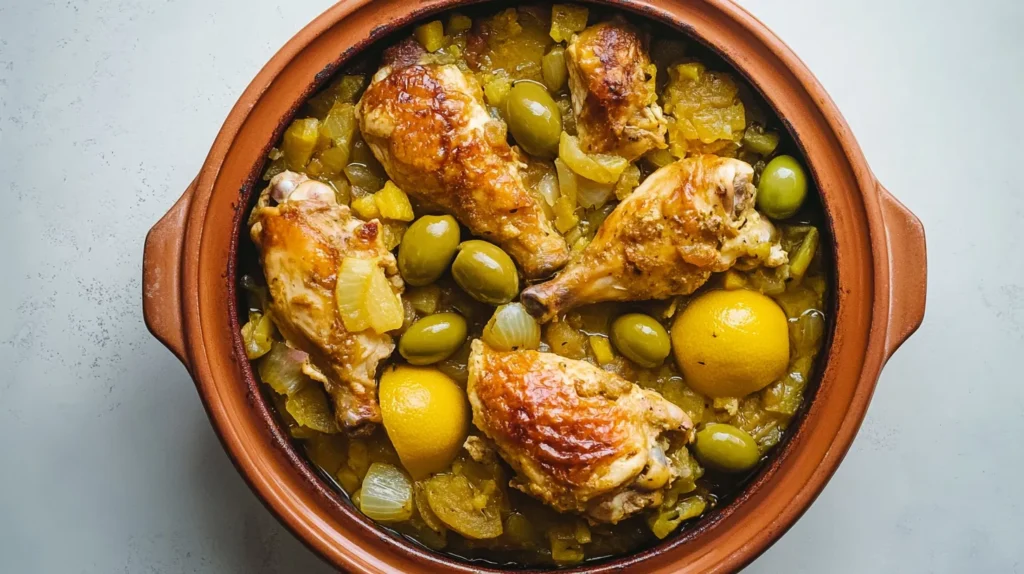Are you ready to explore North Africa through food? Wondering about Moroccan Chicken Tagine in Moroccan cuisine? It’s famous for its deep flavors and spices, making it a must-try.
This recipe brings North Africa’s flavors to your home. It combines spices, garlic, onion, olives, and preserved lemons. Moroccan Chicken Tagine will take your taste buds on a journey.
Key Takeaways
- Easy-to-follow recipe for a traditional North African dish
- Rich flavors and aromatic spices
- Blend of spices, garlic, onion, olives, and preserved lemons
- Perfect for a culinary adventure
- Transports your taste buds to a different world
- Great for those looking to try new flavors
The Rich Heritage of Moroccan Tagine Cooking
In the heart of Moroccan cuisine lies the Tagine, a dish that not only represents the country’s gastronomic identity but also its rich cultural heritage. This traditional North African stew has been a cornerstone of authentic Moroccan cuisine for centuries.
Origins of Tagine in North African Cuisine
The origins of Tagine are deeply rooted in North African culinary traditions, where slow-cooked stews have been a staple for generations. The name “Tagine” refers not only to the dish itself but also to the unique conical-lidded earthenware pot in which it is cooked. This traditional cooking vessel plays a crucial role in the flavor and texture of the final dish.
- The use of a Tagine pot allows for the distribution of heat and the condensation of steam, enhancing the flavors.
- Traditional Tagine dishes often feature a combination of meats, vegetables, and dried fruits, showcasing the diversity of North African cuisine.
Cultural Significance in Moroccan Traditions
Tagine holds a special place in Moroccan culture, often serving as the centerpiece for family gatherings and special occasions. The preparation and sharing of Tagine are considered acts of hospitality and generosity, reflecting the values of Moroccan society.
The cultural significance of Tagine is also evident in its presence at traditional celebrations and its role in passing down culinary knowledge from one generation to the next.
Understanding the Tagine: Dish vs. Cooking Vessel
In Moroccan cuisine, ‘tagine’ means both the cooking pot and the delicious stew it makes. This can be confusing for newcomers. But knowing both parts is key to enjoying traditional tagine dishes and learning Moroccan cooking.
The Traditional Clay Tagine Pot
The traditional clay tagine pot is a special cooking vessel used for ages in North Africa. It has a shallow base and a tall, conical lid. This design helps in cooking by trapping steam, making the stew moist and flavorful.
Modern Adaptations for Home Cooking
While the traditional clay tagine pot is iconic, it’s not the only way to make a tagine. Modern cooks can use Dutch ovens or slow cookers to get similar results. These options let anyone make a tasty tagine without needing a special pot.
| Cooking Vessel | Characteristics | Adaptability for Tagine |
|---|---|---|
| Traditional Clay Tagine | Clay material, conical lid | Authentic, designed for tagine |
| Dutch Oven | Thick walls, heavy lid | High, replicates slow cooking |
| Slow Cooker | Electric, controlled heat | High, ideal for long, slow cooking |
Understanding both the cooking vessel and the dish helps home cooks appreciate Moroccan cuisine. They can then adapt these recipes to their kitchens.
Essential Ingredients for an Authentic Moroccan Chicken Tagine
Moroccan Chicken Tagine is famous for its rich flavors. It depends on the quality of its ingredients. The dish’s authenticity comes from choosing the right chicken, spices, herbs, and fresh produce.
Selecting the Right Chicken Cuts
For a flavorful chicken tagine, picking the right chicken is key. Bone-in skin-on chicken thighs are best. They stay juicy during the long simmering time, making the dish tender and flavorful.
Traditional Moroccan Spices and Herbs
Moroccan cooking is all about its spices and herbs. A homemade tagine spice blend is essential. Ras el Hanout is a key part of this blend.
Ras el Hanout: The Signature Spice Blend
Ras el Hanout means “head of the shop.” It’s a mix of over 30 spices like cumin, coriander, and cinnamon. This blend gives Moroccan dishes their deep, aromatic flavors.
Fresh Herbs That Enhance Flavor
Fresh herbs like parsley, cilantro, and dill add freshness to the tagine. They improve the flavor and aroma of the dish.
Fresh Produce and Preserved Elements
Fresh ingredients like onions, garlic, and sometimes preserved lemons and olives, are crucial. They add sweetness, tanginess, and depth to the tagine.
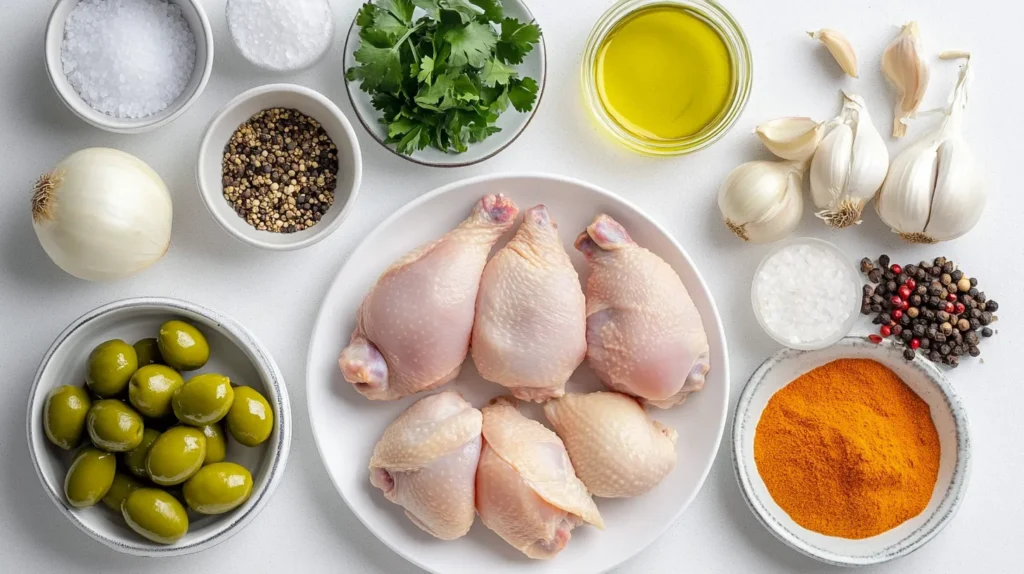
| Ingredient | Description | Role in Tagine |
|---|---|---|
| Chicken Thighs | Bone-in, skin-on | Main protein, remains juicy |
| Ras el Hanout | Complex spice blend | Signature flavor, aromatic |
| Preserved Lemons | Salted, pickled lemons | Adds tanginess, depth |
| Fresh Herbs | Parsley, cilantro, dill | Freshness, aromatic flavor |
Creating Your Own Moroccan Spice Blend
Moroccan cuisine is famous for its rich flavors, thanks to the Ras el Hanout spice blend. You can make it yourself. This blend, meaning “head of the shop,” is a mix of the finest spices. Its ingredients can change a lot, depending on the recipe or vendor.
Making your own blend lets you have a consistent flavor. It’s also more affordable than buying pre-made ones.
Key Spices for Authentic Flavor
Ras el Hanout is known for its complexity and flexibility. Common ingredients include cumin, coriander, cinnamon, ginger, and turmeric. Some recipes use over 30 spices.
The goal is to mix warm, aromatic flavors with a bit of heat. Cardamom, cloves, and nutmeg add depth. Cayenne pepper or chili powder add spiciness.
Mixing and Storing Your Homemade Blend
To make your blend, mix the spices you like in the right amounts. Toasting whole spices before grinding makes them taste better. Store your homemade tagine spice blend in an airtight container, away from light and heat.
This keeps its flavor strong. You’ll always have fresh spice for your Moroccan cooking techniques. Your dishes will always taste authentic.
By making your own Ras el Hanout, you’re joining a long tradition of authentic Moroccan cuisine. Try different amounts to find your favorite mix. Enjoy the rich flavor it brings to your cooking.
Preparing Your Ingredients for the Perfect Tagine
The secret to a flavorful chicken tagine is in how you prepare its ingredients. Good preparation boosts flavor and ensures even cooking and a beautiful presentation.
Start by preparing all ingredients as per Moroccan cooking techniques. This means marinating the chicken, chopping veggies, and measuring spices.
Marinating Techniques for Maximum Flavor
Marinating the chicken is key for a flavorful chicken tagine. Mix chicken with olive oil, lemon juice, garlic, ginger, and Moroccan spices. Let it marinate for at least 30 minutes, or better, several hours or overnight in the fridge.
Season the chicken with salt and pepper on both sides. Heat oil in a large Dutch oven or heavy-bottomed pan over medium-high heat until it smokes. Brown the chicken pieces, skin side down, until they’re deep golden, about 5 minutes.
Vegetable Preparation Tips
Preparing vegetables is vital for an easy Moroccan recipe like chicken tagine. Chop or slice onions, garlic, ginger, and other veggies as the recipe requires.
For a tagine, soften onions and garlic by sautéing them in oil over medium heat. They should become translucent and fragrant.
Step-by-Step Cooking Process for Moroccan Chicken Tagine
The Moroccan Chicken Tagine recipe is a journey of flavors. It starts with browning the chicken and ends with a tender stew. This dish is a heart of Moroccan cuisine, known for its rich tastes and hearty ingredients.
Initial Browning and Flavor Building
The first step is to brown the chicken. Heat oil in the tagine or a large pan over medium-high heat. Add the chicken pieces, skin side down, and cook until golden brown.
This step is key as it locks in the flavors and creates a rich crust. After browning, remove the chicken and set it aside.
Layering Ingredients in the Tagine
Layering is crucial in Moroccan cooking techniques. Start with sliced onions at the bottom of the tagine. Then, add the browned chicken on top of the onions.
Next, sprinkle spices like cumin, coriander, and cinnamon over the chicken. If using dried apricots, soak them in boiling water for 30 minutes before adding them. This step boosts flavor and texture.
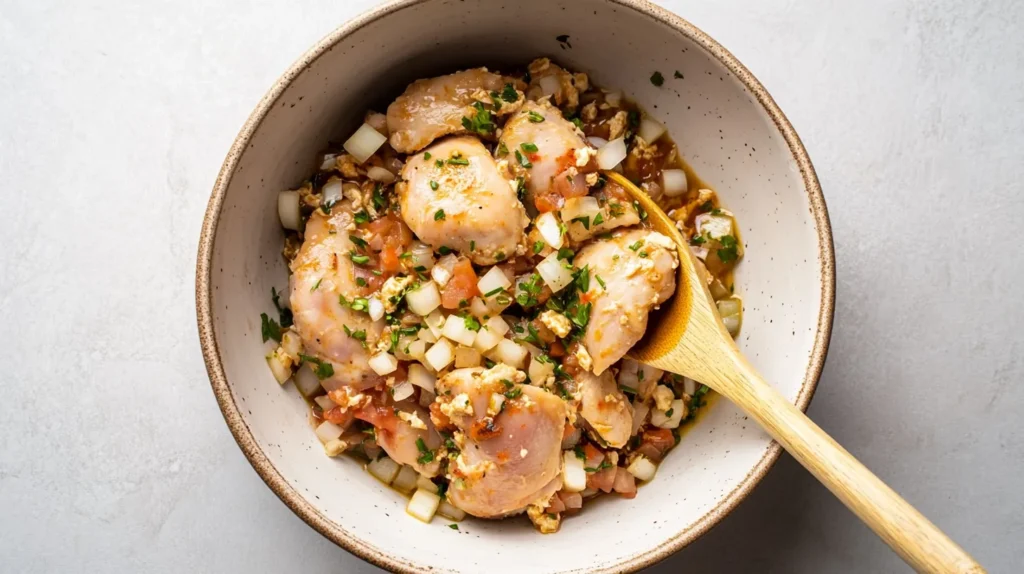
Slow Cooking Methods and Timing
Once all ingredients are in the tagine, it’s time for slow cooking. Cover the tagine with its conical lid and place it over low heat. The slow cooking melds flavors and tenderizes the chicken.
The cooking time is about 45 minutes to an hour. This allows the chicken to be tender and the sauce to thicken.
Knowing When Your Tagine is Perfectly Done
The tagine is done when the chicken is tender and the sauce is thick. Check by inserting a fork into the chicken; if it slides in easily, it’s cooked. The aromas of spices and chicken should blend, creating a rich fragrance.
Serve the Moroccan Chicken Tagine hot, garnished with fresh herbs. Enjoy it with couscous or bread.
Alternative Cooking Methods Without a Traditional Tagine
You don’t need a traditional tagine to make delicious Moroccan Chicken Tagine. Many home cooks have successfully adapted this recipe to various cooking vessels. They’ve achieved equally flavorful results by adjusting cooking techniques for different pots and pans.
Dutch Oven Adaptation
A Dutch oven is a great alternative for cooking Moroccan Chicken Tagine. Its thick walls and tight-fitting lid help distribute heat evenly. This keeps moisture in, just like a traditional tagine. To cook in a Dutch oven, follow your recipe as you would with a tagine. Just adjust the heat to a low simmer once the ingredients boil.
Benefits of using a Dutch oven:
- Even heat distribution
- Moisture retention
- Versatility on stovetop or in oven
Slow Cooker Method
For a hands-off approach, try using a slow cooker. Brown your chicken and cook your aromatics first. Then, transfer everything to the slow cooker. This step boosts the flavor of your tagine. Cook on low for 6-8 hours or high for 3-4 hours.
Tips for slow cooker tagine:
- Brown ingredients before slow cooking
- Adjust seasoning before serving
- Serve with couscous or bread
Pressure Cooker/Instant Pot Variation
If you’re short on time, a pressure cooker or Instant Pot can save you time. Brown your chicken and cook your spices in the pot first. Then, add other ingredients. Cook on high pressure for about 15-20 minutes, followed by a natural release.
Advantages of pressure cooking:
- Reduced cooking time
- Energy efficiency
- Retention of flavors and nutrients
Serving Suggestions and Traditional Accompaniments
Moroccan Chicken Tagine is best enjoyed with traditional sides. The right accompaniments enhance its flavors and the dining experience.
Couscous and Other Grain Options
Couscous is the traditional grain for Chicken Tagine. It’s light and fluffy, perfect for soaking up the sauce. Add dried fruit and nuts for a touch of elegance. You can also try quinoa or bulgur for a healthier option.
Bread Varieties for Serving
Moroccan bread, like Khobz, pairs well with Tagine. Its crusty outside and soft inside are great for dipping. For an authentic touch, serve with Khobz or Matlou.
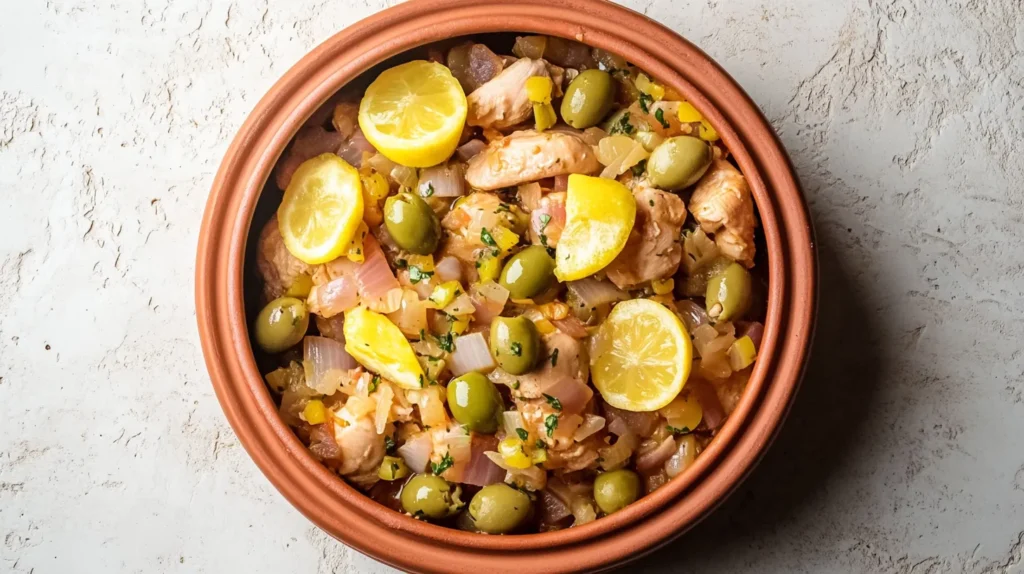
Presentation Tips for an Authentic Experience
Presentation is key in Moroccan dining. Serve the Tagine in its cooking vessel for authenticity. Garnish with fresh herbs and add a lemon wedge. The colors and aromas will make you feel like you’re in Morocco.
By focusing on these details, you’ll have a memorable and flavorful chicken tagine experience.
Nutritional Benefits of Moroccan Chicken Tagine
Moroccan Chicken Tagine is a flavorful dish that’s also good for you. It’s full of nutrients, making it a healthy choice for your meals.
Protein and Essential Nutrients
Chicken thighs in Moroccan Chicken Tagine are a great source of protein. They stay tender even when cooked a bit longer. The bones and skin add flavor to the sauce.
The dish is also rich in vegetables and spices. These add to its nutritional value.
Chicken, vegetables, and spices make Tagine a nutrient-rich meal. Chicken is full of protein, which helps muscles grow. Vegetables bring fiber, vitamins, and minerals. Spices add antioxidants.
Health Properties of Traditional Spices
The spices in Moroccan Chicken Tagine, like cumin, coriander, and turmeric, are good for you. Turmeric has anti-inflammatory properties. Cumin and coriander help with digestion and offer antioxidants.
The spices in Tagine make it not only tasty but also healthy. They can help lower the risk of chronic diseases.
Popular Variations of Moroccan Chicken Tagine
Moroccan Chicken Tagine is loved for its many variations. It has been passed down through generations. Each cook adds their own special touch to the recipe.
Regional Differences Within Morocco
In Morocco, Chicken Tagine changes a lot from one region to another. In the north, tagines are flavored like the Mediterranean. In the south, Sahara-desert spices are used.
- Tagines from the Atlas Mountains often include locally foraged herbs.
- Coastal regions may add seafood or preserved lemons to their tagines.
Sweet and Savory Combinations
Moroccan Chicken Tagine is known for its mix of sweet and savory. This comes from ingredients like dried fruits, honey, and spices.
Tagine with Dried Fruits
Dried fruits like apricots or prunes add sweetness to the tagine. This mix is both traditional and delicious, offering a rich flavor.
Honey and Spice Variations
Some recipes use honey for sweetness, with cinnamon and ginger spices. This is great for those who like a bit of sweetness in their savory dishes.
Seasonal Adaptations
The Chicken Tagine changes with the seasons. Summer tagines have fresh veggies, while winter ones have root veggies.
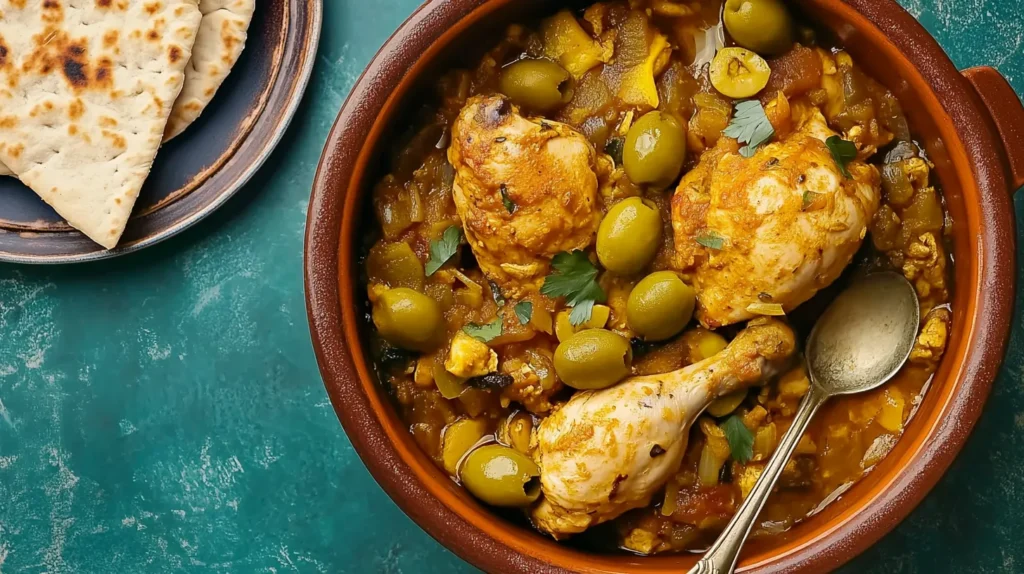
Conclusion
Moroccan Chicken Tagine is a journey of rich flavors and traditions. It’s easy to make and perfect for exploring Moroccan cuisine. The tender chicken, spices, and slow-cooked goodness make it a favorite.
The moroccan chicken tagine recipe is delicious and versatile. You can try different ingredients and variations to make it your own. It works well in traditional clay pots or modern cooking vessels, always tasting great.
This chicken tagine recipe is great for beginners in Moroccan cooking. It introduces you to the world of easy moroccan recipes. The spices, slow cooking, and presentation all create a real Moroccan experience.
So, get your ingredients ready and choose your cooking method. Start your culinary adventure with Moroccan Chicken Tagine. Your taste buds will love the complex flavors and aromas of this North African dish.

